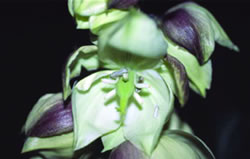The
flowers that keep
Their odor to themselves all day,
But when the sunlight dies away,
Let the delicious secret out
To every breeze that roams about.
--Anonymous
After dark wildflower watching is not a major spectator
event in Moab. But, for those that do venture out
at night, there are “delicious secrets” to
discover.
Flowers that open at night attract moths, beetles
or wasps (sometimes bats) depending upon the size
of the flower. Other pollinators take advantage of
these flowers that open in the late afternoon or
are still blooming in the morning hours. These are
opportunists, not the regular crowd.
Many, but certainly not all, night-blooming flowers
are white. The flowers release scents onto the night
air that lure in the pollinators.
Of these night-bloomers, most bear flowers with deep
corolla tubes. This design provides that moths, with
their long tongues, can reach the nectar rewards
at the tube’s base. Some plants like the yuccas
do not have a tubular corolla, but they have a nyctinastic
tendency – meaning the flowers move about at
night to ease the entry for visiting moths.
During the day, yucca flowers hang downwards with
the petals “close-lipped.” At night,
the flowers turn upward and the petals open slightly.
The flowers also release a sweet, soapy scent that
helps to attract the yucca or pronuba moth – the
specific pollinator.
The relationship between the yucca and the moth is
mutually beneficial to both plant and insect. The
female moth visits a flower and rolls a small ball
of pollen that she carries to another plant. As she
stuffs the pollen mass into the flower’s stigma
(pollen receptor), she also deposits fertilized eggs
into the plant’s ovary. The act of pollination
assures that her developing larvae will be able to
feed on the maturing seeds.
With a flashlight and some rearranging of the yucca’s
petals, you can easily watch this event unfold. The ½” long
moths crawl all over the flowers and seem out of
place under the canopy of petals.
If you have great patience, another nocturnal wildflower
event to watch is the floral opening of dwarf evening
primroses. These low growing plants occur throughout
the desert, sometimes in great abundance. When mature,
the pressure from the swelling petals forces the
protective sepals to burst apart and curve backwards.
The ghostly white petals, connected at the tip by
a tiny spur, start to unfurl and break this clasp.
The process takes about 30 minutes, but is one desert
spectacle rarely viewed.
The evening primrose flowers attract white-lined
sphinx moths – large moths that are often mistaken
for hummingbirds because of their size and flying
abilities. These moths uncurl their long tongues
to reach the nectar rewards deep within the flower’s
trumpet-shaped corolla. In the process, pollen rubs
off on the foreheads and is transferred to other
flowers by these large moths.
By evening’s end, the opened flower will fade
from white to pink. This signals the end of this
flower’s one-day reign.
There are numerous other flowers that are also worth
watching in the evening. There are sacred daturas,
showy four-o’clocks with their beautiful magenta
flowers, blazing stars, lizard-tail guaras, and sand
verbenas to name a few. The verbenas have snowball-like
clusters of flowers that unleash a very sweet aroma.
The flowers attract moths at night, although butterflies
take advantage of open flowers in the late afternoon
or early morning.
So as the sun sets, don’t give up on the desert
flowers. Some of the best blooming is still to happen
in the moonlight garden.

|
|